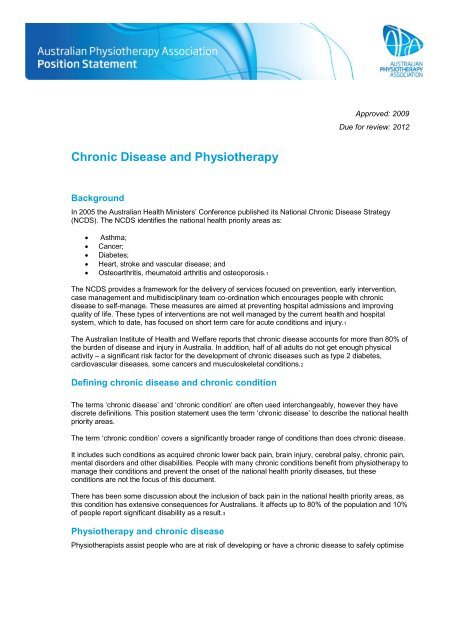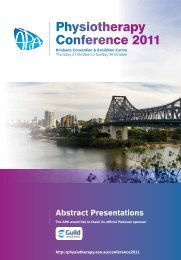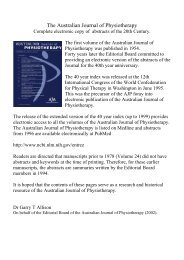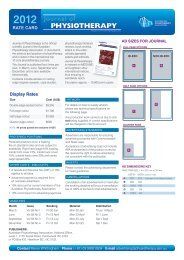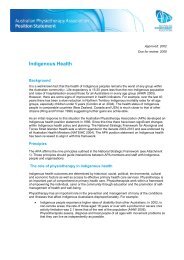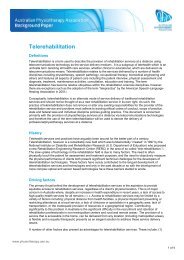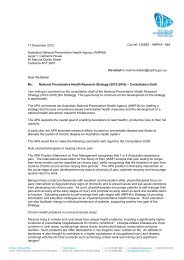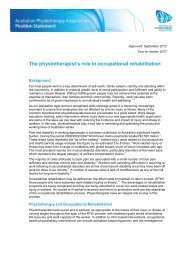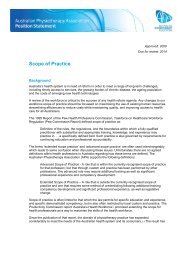Chronic Disease and Physiotherapy - Australian Physiotherapy ...
Chronic Disease and Physiotherapy - Australian Physiotherapy ...
Chronic Disease and Physiotherapy - Australian Physiotherapy ...
Create successful ePaper yourself
Turn your PDF publications into a flip-book with our unique Google optimized e-Paper software.
Approved: 2009<br />
Due for review: 2012<br />
<strong>Chronic</strong> <strong>Disease</strong> <strong>and</strong> <strong>Physiotherapy</strong><br />
Background<br />
In 2005 the <strong>Australian</strong> Health Ministers’ Conference published its National <strong>Chronic</strong> <strong>Disease</strong> Strategy<br />
(NCDS). The NCDS identifies the national health priority areas as:<br />
<br />
<br />
<br />
<br />
<br />
Asthma;<br />
Cancer;<br />
Diabetes;<br />
Heart, stroke <strong>and</strong> vascular disease; <strong>and</strong><br />
Osteoarthritis, rheumatoid arthritis <strong>and</strong> osteoporosis.1<br />
The NCDS provides a framework for the delivery of services focused on prevention, early intervention,<br />
case management <strong>and</strong> multidisciplinary team co-ordination which encourages people with chronic<br />
disease to self-manage. These measures are aimed at preventing hospital admissions <strong>and</strong> improving<br />
quality of life. These types of interventions are not well managed by the current health <strong>and</strong> hospital<br />
system, which to date, has focused on short term care for acute conditions <strong>and</strong> injury.1<br />
The <strong>Australian</strong> Institute of Health <strong>and</strong> Welfare reports that chronic disease accounts for more than 80% of<br />
the burden of disease <strong>and</strong> injury in Australia. In addition, half of all adults do not get enough physical<br />
activity – a significant risk factor for the development of chronic diseases such as type 2 diabetes,<br />
cardiovascular diseases, some cancers <strong>and</strong> musculoskeletal conditions.2<br />
Defining chronic disease <strong>and</strong> chronic condition<br />
The terms ‘chronic disease’ <strong>and</strong> ‘chronic condition’ are often used interchangeably, however they have<br />
discrete definitions. This position statement uses the term ‘chronic disease’ to describe the national health<br />
priority areas.<br />
The term ‘chronic condition’ covers a significantly broader range of conditions than does chronic disease.<br />
It includes such conditions as acquired chronic lower back pain, brain injury, cerebral palsy, chronic pain,<br />
mental disorders <strong>and</strong> other disabilities. People with many chronic conditions benefit from physiotherapy to<br />
manage their conditions <strong>and</strong> prevent the onset of the national health priority diseases, but these<br />
conditions are not the focus of this document.<br />
There has been some discussion about the inclusion of back pain in the national health priority areas, as<br />
this condition has extensive consequences for <strong>Australian</strong>s. It affects up to 80% of the population <strong>and</strong> 10%<br />
of people report significant disability as a result.3<br />
<strong>Physiotherapy</strong> <strong>and</strong> chronic disease<br />
Physiotherapists assist people who are at risk of developing or have a chronic disease to safely optimise
their level of physical activity. They also help people with chronic diseases to safely <strong>and</strong> effectively<br />
manage their own care.<br />
Being primary contact professionals with excellent communication skills, physiotherapists are accessible<br />
to members of their local community. They are well placed to promote physical activity guidelines <strong>and</strong><br />
healthy lifestyle. The potential for physiotherapy to impact on chronic disease prevention <strong>and</strong><br />
management is currently restricted by financial barriers.<br />
There are a number of distinct ways in which physiotherapists can actively contribute to decreasing the<br />
burden of chronic disease in Australia.<br />
Health promotion<br />
Physiotherapists work at public events, within hospitals <strong>and</strong> community health clinics <strong>and</strong> as first contact<br />
professionals within primary care settings such as ambulatory services <strong>and</strong> private practices. They work<br />
with clients across the age spectrum from infants <strong>and</strong> children through to aged populations. This places<br />
physiotherapists in an ideal position to provide information <strong>and</strong> advice to people suffering from or at risk of<br />
developing all forms of chronic disease.<br />
Physical activity is recommended for the prevention or treatment of many chronic diseases.4<br />
Physiotherapists can prescribe <strong>and</strong> implement therapeutic exercise at an individual or group level, <strong>and</strong><br />
lead exercise <strong>and</strong> education classes for people who have been diagnosed with or are at risk of<br />
developing chronic diseases such as type 2 diabetes, cardiorespiratory, vascular <strong>and</strong> musculoskeletal<br />
conditions.<br />
The role of the physiotherapist in chronic disease management<br />
General practitioners have perhaps the most well recognised role in the management of chronic disease<br />
<strong>and</strong> are vital to the care of people with or at risk of developing these diseases. However it is less well<br />
recognised that other health professionals have a significant part to play in the management of chronic<br />
disease.<br />
Physiotherapists are primary contact practitioners, <strong>and</strong> have the expertise to manage the care of clients at<br />
various stages of the chronic disease continuum. There are many examples of physiotherapy<br />
interventions in the NCDS areas. Physiotherapists manage people with chronic lung diseases including<br />
asthma through exercise prescription <strong>and</strong> cardio-pulmonary rehabilitation.5 People with complications<br />
from cancer surgery such as lymphoedema are treated by physiotherapists using complex physical<br />
therapy (CPT)6, <strong>and</strong> physiotherapists prescribe exercise therapy to improve glucose control in people with<br />
or at risk of developing diabetes7. Other examples include physiotherapy management of cardiac<br />
rehabilitation programs for people with various forms of heart disease8 <strong>and</strong> the rehabilitation of elderly<br />
people after a stroke.9 Physiotherapists also provide interventions including therapeutic exercise to<br />
reduce the risk of osteoporotic fracture.10 & 11<br />
Enabling people to self manage their condition<br />
Person-centred health care entails the building of partnerships with people to enable them to maintain<br />
optimal function <strong>and</strong> independence.12 Self-management is part of this process <strong>and</strong> strategies to facilitate<br />
self care have a focus on providing information to people with chronic diseases on lifestyle modification,<br />
support mechanisms in the healthcare systems, <strong>and</strong> how <strong>and</strong> when to access services. The aim is to<br />
work in partnership with people to empower them to set goals, take a greater role in the management of<br />
their own condition, <strong>and</strong> to be able to source reliable information on their disease. Physiotherapists can<br />
provide education that takes place in a variety of settings, ranging from one on one consultations to<br />
formal group education sessions including disease specific self-management classes.<br />
www.physiotherapy.asn.au<br />
2 of 5
Access to a greater range of health providers has been linked to the capacity to build more effective self<br />
management techniques <strong>and</strong> accountability in people with chronic disease.13 For example there is<br />
evidence that people with heart failure enrolled in programs that feature multidisciplinary team care have<br />
shorter inpatient stays <strong>and</strong> lower rates of re-hospitalisation.14 Physiotherapists have the appropriate skills<br />
to empower people to participate in their own healthcare, thus are well placed to assist people to self<br />
manage chronic diseases. They are experienced in pain management techniques <strong>and</strong> have a thorough<br />
underst<strong>and</strong>ing of the biopsychosocial influences that are important in long-term diseases - all factors<br />
important to enable self-care for chronic disease.15 & 16<br />
Managing the impact of co-morbidities<br />
Co-morbidities <strong>and</strong> complications are common in chronic diseases such as type 2 diabetes <strong>and</strong><br />
cardiovascular disease.17 This can complicate self-management <strong>and</strong> the provision of therapy.<br />
Physiotherapists have the expertise, including a broad skill base <strong>and</strong> an excellent knowledge of pathology<br />
<strong>and</strong> its impact on exercise prescription, to effectively manage many aspects of care for people with<br />
chronic disease.<br />
For example, a person with osteoarthritis of the knee in combination with impaired glucose tolerance may<br />
benefit from an exercise program to manage the risk of developing type 2 diabetes, but knee pain may<br />
prevent participation in a st<strong>and</strong>ard program. Physiotherapists can address this barrier by initially treating<br />
the primary symptoms of the osteoarthritis, then modifying <strong>and</strong> supervising an exercise program to<br />
optimise opportunities for participation, thus improving the individual’s wellbeing <strong>and</strong> quality of life.<br />
<strong>Physiotherapy</strong> services can be provided on an individual basis or within group sessions. These offer a<br />
supervised environment for people with chronic disease <strong>and</strong> associated co-morbidities to exercise safely<br />
<strong>and</strong> effectively. Services can include advice <strong>and</strong> education on physical activity levels <strong>and</strong>, in combination<br />
with other members of the multidisciplinary team, on lifestyle modifications such as smoking cessation,<br />
reduction of alcohol intake, pain <strong>and</strong> fatigue management strategies or dietary advice.18 & 19<br />
<strong>Physiotherapy</strong> interventions for the symptoms associated with chronic<br />
disease<br />
The role of physiotherapy interventions to treat the symptoms associated with chronic disease is well<br />
recognised. Some examples include the use of physiotherapy interventions to provide relief from pain<br />
resulting from osteoarthritis20 as well as improving functional range of movement <strong>and</strong> strength, or help to<br />
improve exercise capacity <strong>and</strong> reduce shortness of breath in people with chronic obstructive pulmonary<br />
disease (COPD) or heart disease21.<br />
The APA position<br />
Physiotherapists are able to positively impact on Australia’s burden of chronic disease through health<br />
promotion, providing assistance with disease management <strong>and</strong> facilitating self-management, dealing with<br />
the co-morbidities associated with chronic disease <strong>and</strong> addressing the symptoms of chronic disease.<br />
The position of the <strong>Australian</strong> <strong>Physiotherapy</strong> Association is that:<br />
Physiotherapists offer a wide variety of services to people at risk of developing or who have<br />
chronic disease. These services occur in a variety of highly accessible community <strong>and</strong> inpatient<br />
settings, in both private <strong>and</strong> public sectors<br />
Optimal treatment for people with chronic disease is person-centred, promotes self-management,<br />
<strong>and</strong> involves multidisciplinary team care which includes physiotherapy<br />
Physiotherapists have the necessary expert knowledge to prevent <strong>and</strong> manage the comorbidities<br />
<strong>and</strong> complications of chronic disease<br />
Where there is evidence for the efficacy of physiotherapy interventions, such interventions should<br />
be funded through the MBS<br />
www.physiotherapy.asn.au<br />
3 of 5
The current funding mechanisms that support multidisciplinary team care limit the ability of<br />
people with or at risk of developing chronic diseases to pay for adequate levels of physiotherapy<br />
service, particularly where co-morbidities exist. Supervised group programs are a cost effective<br />
way of preventing <strong>and</strong> managing many chronic diseases, yet funding restricts the affordability of<br />
group sessions for people who would benefit most from these services<br />
Current Medicare funding mechanisms do not support health professionals to use their clinical<br />
judgement to assess the number <strong>and</strong> type of interventions required to provide person-centred<br />
team care. Instead, they are rigid <strong>and</strong> prescriptive. This severely limits attendance <strong>and</strong> thus the<br />
opportunity for physiotherapy to improve wellness <strong>and</strong> quality of life<br />
Private health insurers should support chronic disease prevention <strong>and</strong> management programs<br />
through rebates to their members for suitable physiotherapy programs<br />
Funding must be flexible enough to ensure that people with chronic disease are not denied<br />
access to innovative <strong>and</strong> cost effective treatments, including classes <strong>and</strong> self-management<br />
education sessions run by skilled health professionals such as physiotherapists<br />
Mechanisms to assess the clinical efficacy <strong>and</strong> cost effectiveness of treatments for chronic<br />
diseases currently listed on the Medicare Benefits Schedule (MBS) are limited. The APA believes<br />
that emphasis should be placed on the development of these mechanisms.<br />
References<br />
1. National Health Priority Action Council (NHPAC) (2006). National <strong>Chronic</strong> <strong>Disease</strong> Strategy,<br />
<strong>Australian</strong> Government Department of Health <strong>and</strong> Ageing.<br />
2. <strong>Australian</strong> Institute of Health <strong>and</strong> Welfare (2006). <strong>Chronic</strong> diseases <strong>and</strong> associated risk factors<br />
Australia, 2006 Cat. No. PHE 81. Canberra: AIHW.<br />
3. Briggs, A. M. & Buchbinder, R. (2009). Back pain: a National Health Priority Area in Australia? The<br />
Medical Journal of Australia. May; 190(9):499-502<br />
4. Armstrong, T., Bauman, A. & Davies, J. (2000). Physical activity patterns of <strong>Australian</strong> adults.<br />
Results of the 1999 National Physical Activity Survey. Canberra: AIHW.<br />
5. Cambach, W., Wagenaar, R. C., Koelman, T. W. & van Keimpema, A. R., Kemper, H. C. (1999).<br />
The long-term effects of pulmonary rehabilitation in patients with asthma <strong>and</strong> chronic obstructive<br />
pulmonary disease: a research synthesis. Physical Medicine <strong>and</strong> Rehabilitation, 80:1, 103-111<br />
6. McCallin, M., Johnston, J. & Bassett, S. (2005). How effective are physiotherapy techniques to<br />
treat established secondary lymphoedema following surgery for cancer? A critical analysis of the<br />
literature. New Zeal<strong>and</strong> Journal of <strong>Physiotherapy</strong>. 33(3), 101-112<br />
7. Yassine, H., Marchetti, C., Krishnan, R., Vrobel, T., Gonzalez, F., & Kirwan, J. (2009). Effects of<br />
Exercise <strong>and</strong> Caloric Restriction on Insulin Resistance <strong>and</strong> Cardiometabolic Risk Factors in Older<br />
Obese Adults-A R<strong>and</strong>omized Clinical Trial. The Journals of Gerontology: Series A Biological<br />
sciences <strong>and</strong> medical sciences, 64A(1), 90-5<br />
8. Jolliffee, J., Taylor, R. & Ebrihaim, S. (2000). A report on the clinical <strong>and</strong> cost effectiveness of<br />
physiotherapy in cardiac rehabilitation. London: Chartered Society of <strong>Physiotherapy</strong>.<br />
9. Forster, A. & Young, J. (2002). The clinical <strong>and</strong> cost effectiveness of physiotherapy in the<br />
management of elderly people following a stroke. London: Chartered Society of <strong>Physiotherapy</strong>.<br />
Available on www.csp.org.au; retrieved 29 September 2009.<br />
10. Chartered Society of <strong>Physiotherapy</strong> <strong>and</strong> the National Osteoporosis Society (1999). <strong>Physiotherapy</strong><br />
www.physiotherapy.asn.au<br />
4 of 5
guidelines for the management of osteoporosis. London: Chartered Society of <strong>Physiotherapy</strong>.<br />
11. Zehnacker, C. H. & Bemis-Dougherty, A. (2007). Effect of Weighted Exercises on Bone Mineral<br />
Density in Post Menopausal Women: A Systematic Review. Journal of Geriatric Physical Therapy,<br />
30(2), 79-88<br />
12. Holman, H. & Lorig, K. (2000). Patients as partners in managing chronic disease. British Medical<br />
Journal, 320(7234), 526-7<br />
13. Dennis, S. M., Zwar, N., Griffiths, R., Rol<strong>and</strong>, M., Hasan, I., Davies, G. P. & Harris, M. (2008).<br />
<strong>Chronic</strong> disease management in primary care: from evidence to policy. Medical Journal of<br />
Australia, 188: S53-7<br />
14. Sochalski, J., Jaarsma, T., Krumholz, H. M., Laraamee, A. & McMurry, J. J. V et al. (2009). What<br />
works in chronic care management: the case of heart failure. Health Affairs, 21, :179-189<br />
15. Effing, T., Monninkhof, E. M., van der Valk, P. P., Zeilhuis, G. G. & Walters, E. H., et al. (2007).<br />
Self-management education for patients with chronic obstructive pulmonary disease. Cochrane<br />
Database of Systematic Reviews(4): CD002990.<br />
16. Ries, A. L., Bauldoff, G. S., Carlin, B. W., Casaburi, R. & Emery, C., et al. (2007). Pulmonary<br />
Rehabilitation: Joint ACCP/AACVPR Evidence-Based Clinical Practice Guidelines. Chest 131(5<br />
Suppl): 4S-42S<br />
17. <strong>Australian</strong> Institute of Health <strong>and</strong> Welfare (2008). Diabetes: <strong>Australian</strong> facts 2008. Diabetes series<br />
no. 8. Cat. No. CVD 40. Canberra, AIHW.<br />
18. English, C. K., Hillier, S. L., Stiller, K. R. & Warden-Flood, A. (2007). Circuit class therapy versus<br />
individual physiotherapy sessions during inpatient stroke rehabilitation: a controlled trial. Archives<br />
of Physical Medicine & Rehabilitation 88(8): 955-63<br />
4 5 of 5<br />
19. Macko, R. F., Benvenuti, F., Stanhope, S., Macellari, V. & Taviani, A., et al. (2008). Adaptive<br />
physical activity improves mobility function <strong>and</strong> quality of life in chronic hemiparesis. Journal of<br />
Rehabilitation Research & Development 45(2): 323-8<br />
20. <strong>Australian</strong> <strong>Physiotherapy</strong> Association (2005). Evidence-based Clinical Statement - Knee joint<br />
osteoarthritis. Available on www.physiotherapy.asn.au; retrieved 29 May 2009.<br />
21. <strong>Australian</strong> <strong>Physiotherapy</strong> Association (2005) Position Statement: Evidence regarding therapeutic<br />
exercise in physiotherapy. Available on www.physiotherapy.asn.au; retrieved 29 May 2009.<br />
www.physiotherapy.asn.au<br />
5 of 5


